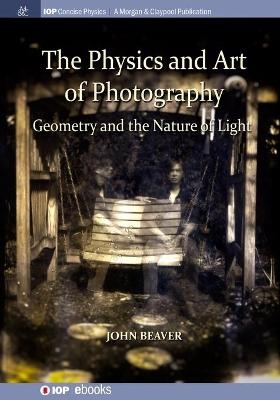
The Physics and Art of Photography, Volume 1
Morgan & Claypool Publishers (Verlag)
978-1-64327-329-7 (ISBN)
This book uses art photography as a point of departure for learning about physics, while also using physics as a point of departure for asking fundamental questions about the nature of photography as an art. Although not a how-to manual, the topics center around hands-on applications, most-often illustrated by photographic processes that are inexpensive and easily accessible to students (including a versatile new process developed by the author, and herein first described in print). A central theme is the connection between the physical interaction of light and matter on the one hand, and the artistry of the photographic processes and their results on the other.
Geometry and the Nature of Light focuses on the physics of light and the optics of lenses, but also includes extended discussions of topics less commonly covered in a beginning text, including symmetry in art and physics, different physical processes of the scattering of light, photograms (photographic shadow prints) and the nature of shadows, elements of 2-dimensional design, pinhole photography and the view camera. Although written at a beginning undergraduate level, the topics are chosen for their role in a more general discussion of the relation between science and art that is of interest to readers of all backgrounds and levels of expertise.
For nearly 20 years, John Beaver has used old processes to make new negatives, often in ways that can only be realized as a print with digital scanning and printing. This includes his development of the cyanonegative process, innovative work (in collaboration with Teresa Patrick) with instant film, and most recently his development of an accelerated, unfixed printing-out process he calls (perhaps annoyingly) ""Ephemeral-Process photography."" He is Professor of Physics and Astronomy at the Fox Valley Campus of University of Wisconsin Oshkosh, where he teaches physics, astronomy, photography and interdisciplinary courses. He earned his B.S. in physics and astronomy in 1985 from Youngstown State University, and his PhD in astronomy in 1992 from Ohio State University. His published work in astronomy is on the topics of spectrophotometry of comets and gaseous nebulae, and multi-color photometry of star clusters. He has exhibited photographs in many juried competitions in Wisconsin, Ohio, New York, Louisiana, Missouri, Oregon and Colorado, even occasionally winning an award or two (well, two actually). He has had several soloexhibitions, as well as joint shows with artists Judith Waller, Diana Ludwig, Dawn Patel and Teresa Patrick. Beaver has long been involved in art-science collaborations (many with artist Judith Waller) in the classroom, at academic conferences, and in art galleries and planetaria.
Preface
Acknowledgements
Author biography
Part I Some preliminary ideas
1. What is science; what is art?
Part II The nature of light
2. What light is
3. What light does
4. Sources of light
5. Wavelength reconsidered
Part III Geometry and two-dimensional design
6. Geometry and the picture plane
7. Light and shadow: photograms
8. Ray optics 1: pinhole photography
9. Ray optics 2: lenses
10. Symmetry
11. Two-dimensional (2D) design
12. The view camera
Appendices
| Erscheinungsdatum | 11.04.2019 |
|---|---|
| Reihe/Serie | IOP Concise Physics |
| Verlagsort | San Rafael |
| Sprache | englisch |
| Maße | 178 x 254 mm |
| Gewicht | 333 g |
| Themenwelt | Naturwissenschaften ► Physik / Astronomie ► Optik |
| ISBN-10 | 1-64327-329-9 / 1643273299 |
| ISBN-13 | 978-1-64327-329-7 / 9781643273297 |
| Zustand | Neuware |
| Haben Sie eine Frage zum Produkt? |
aus dem Bereich


